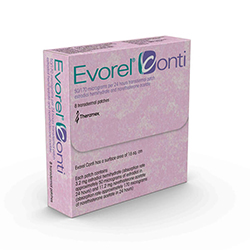Frequently asked questions about Evorel®
What happens if I use more Evorel® Conti than I should?
It is unlikely that you will have too much of the hormones in Evorel Conti. The most common symptoms of having too much oestrogen or progestogen in your body are:
- Tender breasts
- Feeling sick (nausea) or being sick
- Unexpected vaginal bleeding
- Stomach pain or bloating
- Feeling depressed
- Tiredness
- Acne
- Growth of body or facial hair
Removing the patch can reverse the effects of too much oestrogen and/or progestogen. Talk to your doctor or pharmacist before using any more patches.
Can I use Evorel® Conti as a contraceptive?
The levels of hormone from the patches are too low to act as a contraceptive. Talk to your doctor for advice on contraception.
What about Everyday activities with Evorel® Conti?
- You can have a bath or shower as normal. Do not scrub too hard as this can loosen the edges of the patch
- You can go swimming. The patch will not be affected
- You can exercise and play sports. However, do not wear the patch under tight clothing or waist bands
- You can sunbathe. However, keep the patch covered, out of direct sunlight
What possible side effects may I experience with Evorel® Conti?
Like all medicines, this medicine can cause side effects, although not everybody gets them.
The following diseases are reported more often in women using HRT compared to women not using HRT:
- breast cancer
- abnormal growth or cancer of the lining of the womb (endometrial hyperplasia or cancer)
- ovarian cancer
- blood clots in the veins of the legs or lungs (venous thromboembolism)
- heart disease
- stroke
- probable memory loss if HRT is started over the age of 65
Please refer to the Patient Information Leaflet for a full list of possible side effects.
Am I at risk of developing endometrial hyperplasia or endometrial cancer?
Excessive thickening of the lining of the womb (endometrial hyperplasia) and cancer of the lining of the womb (endometrial cancer)
HRT is not recommended for women who have ever had cancer of the lining of the womb.
Using oestrogen-only HRT will increase the risk of excessive thickening of the lining of the womb (endometrial hyperplasia) and cancer of the womb lining (endometrial cancer). The progestogen in Evorel Conti protects you from this extra risk.
How likely is endometrial cancer?
In women who still have a womb and who are not taking HRT, on average, 5 in 1,000 will be diagnosed with endometrial cancer between the ages of 50 and 65.
For women aged 50 to 65 who still have a womb and who take oestrogen-only HRT, between 10 and 60 women in 1,000 will be diagnosed with endometrial cancer (i.e. between 5 and 55 extra cases), depending on the dose and for how long it is taken.
The addition of a progestogen to oestrogen-only HRT substantially reduces the risk of endometrial cancer.
Breast Cancer
- Women who have breast cancer or have had breast cancer in the past should not have HRT.
How likely are breast cancer and ovarian cancer in women taking HRT?
Evidence shows that taking combined oestrogen-progestogen or oestrogen-only hormone replacement therapy (HRT) increases the risk of breast cancer. The extra risk depends on how long you use HRT. The additional risk becomes clear within 3 years of use. After stopping HRT the extra risk will decrease with time, but the risk may persist for 10 years or more if you have used HRT for more than 5 years.
Women aged 50 to 54 who are not taking HRT, on average 13 to 17 in 1000 will be diagnosed with breast cancer over a 5-year period.
- For women aged 50 who start taking oestrogen-only HRT for 5 years, there will be 16-17 cases in 1000 users (i.e. an extra 0 to 3 cases).
- For women aged 50 who start taking oestrogen-progestogen HRT for 5 years, there will be 21 cases in 1000 users (i.e. an extra 4-8 cases).
- Women aged 50 to 59 who are not taking HRT, on average, 27 in 1000 will be diagnosed with breast cancer over a 10-year period.
- For women aged 50 who start taking oestrogen-only HRT for 10 years, there will be 34 cases in 1000 users (i.e. an extra 7 cases)
- For women aged 50 who start taking oestrogen-progestogen HRT for 10 years, there will be 48 cases in 1000 users (i.e. an extra 21 cases).
If you notice any changes in your breast, such as:
· Dimpling of the skin
· Changes in the nipple
· Any lumps you can see or feel
Make an appointment to see your doctor as soon as possible.
Additionally, you are advised to join mammography screening programs when offered to you. For mammogram screening, it is important that you inform the nurse/healthcare professional who is actually taking the x-ray that you use HRT, as this medication may increase the density of your breasts which may affect the outcome of the mammogram. Where the density of the breast is increased, mammography may not detect all lumps.
Ovarian cancer
Ovarian cancer is rare, much rarer than breast cancer. The use of oestrogen-only or combined oestrogen-progestogen HRT has been associated with a slightly increased risk of ovarian cancer.
The risk of ovarian cancer varies with age. For example, in women aged 50 to 54 who are not taking HRT, about 2 women in 2000 will be diagnosed with ovarian cancer over a 5-year period. For women who have been taking HRT for 5 years, there will be about 3 cases per 2000 users (i.e., about 1 extra case).

